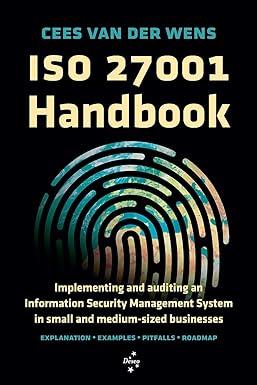Type or paste question here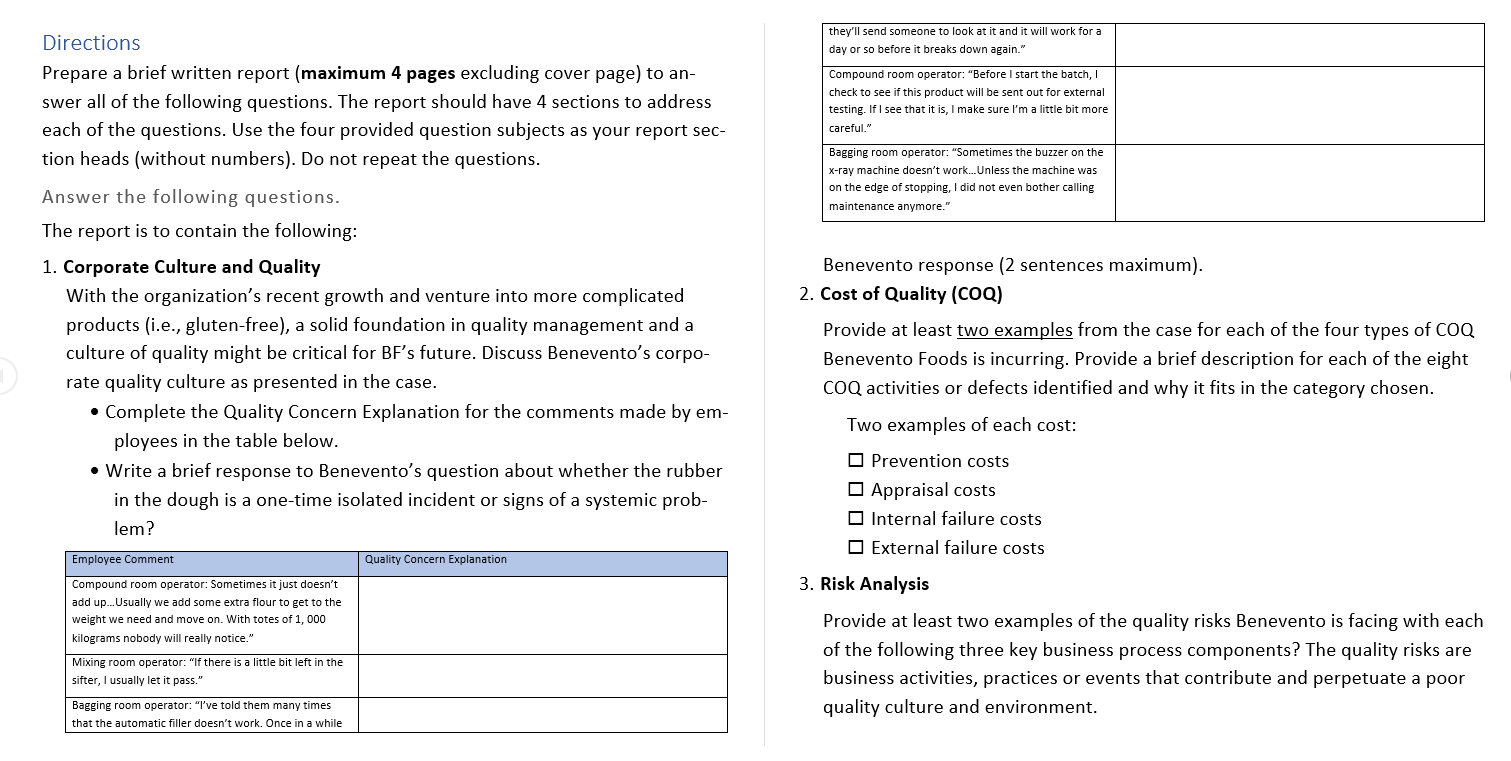
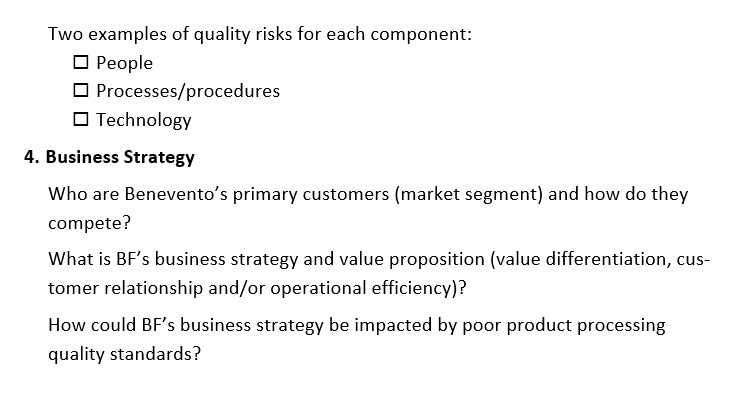
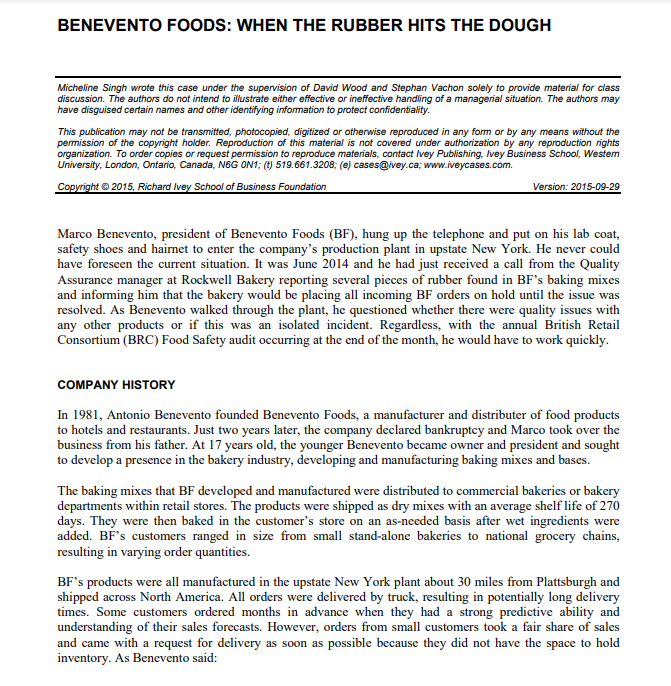
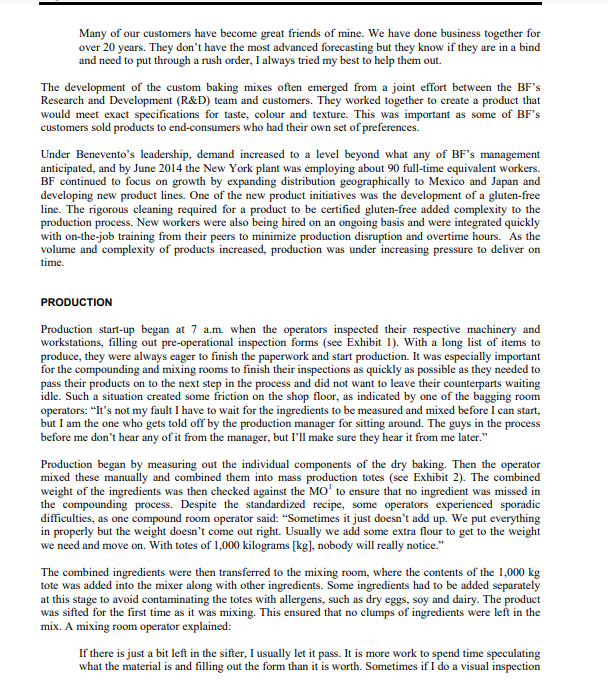
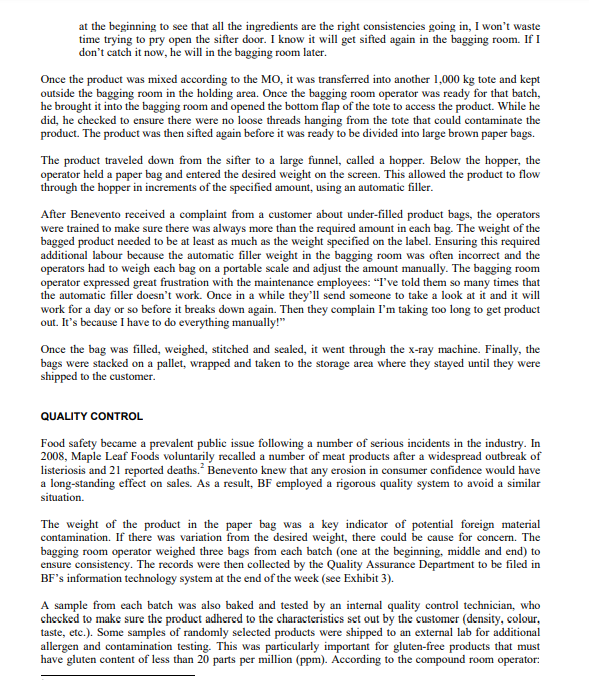
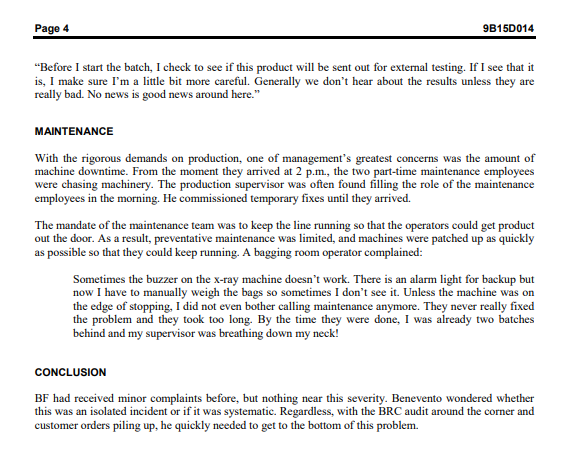
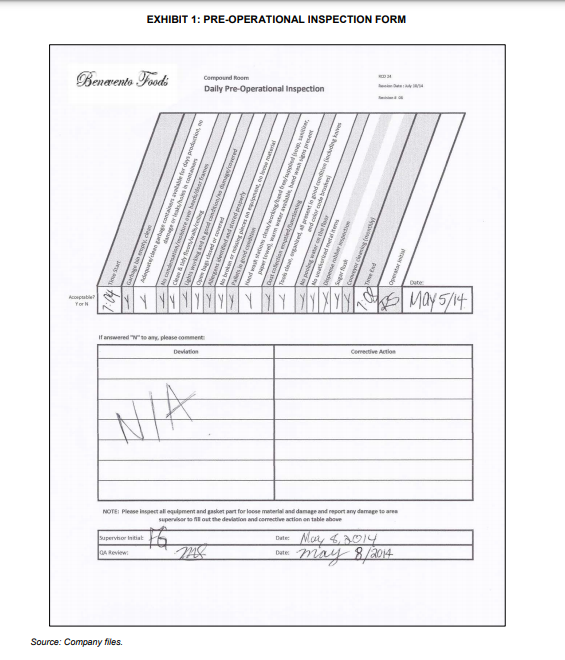
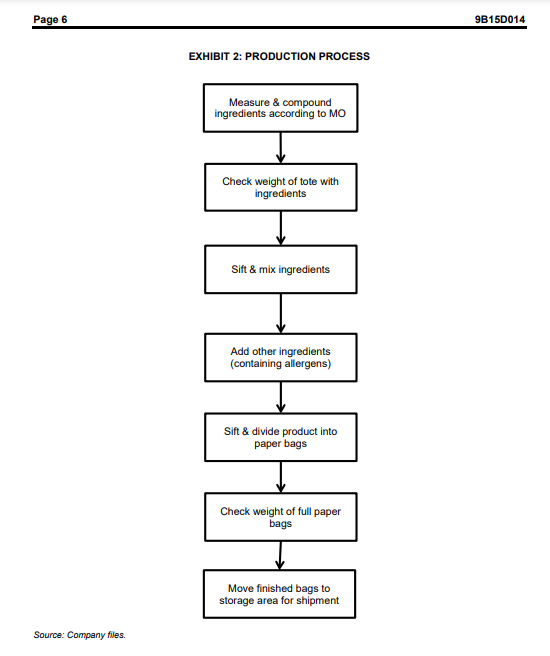
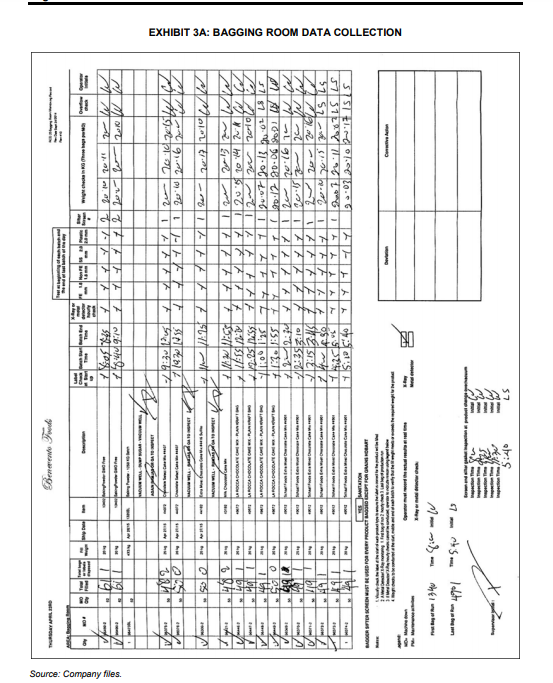
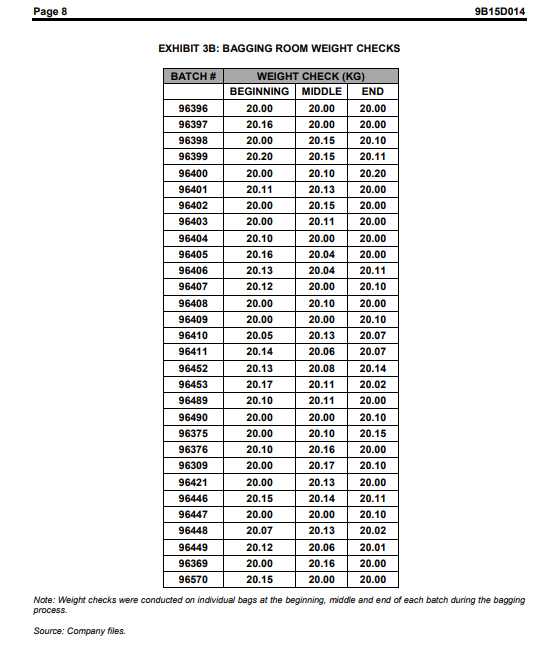
they'll send someone to look at it and it will work for a day or so before it breaks down again." Directions Prepare a brief written report (maximum 4 pages excluding cover page) to an- swer all of the following questions. The report should have 4 sections to address each of the questions. Use the four provided question subjects as your report sec- tion heads (without numbers). Do not repeat the questions. Compound room operator: "Before I start the batch, check to see if this product will be sent out for external testing. If I see that it is, I make sure I'm a little bit more careful." Bagging room operator: "Sometimes the buzzer on the X-ray machine doesn't work...Unless the machine was on the edge of stopping, I did not even bother calling maintenance anymore." Answer the following questions. The report is to contain the following: 1. Corporate Culture and Quality With the organization's recent growth and venture into more complicated products (i.e., gluten-free), a solid foundation in quality management and a culture of quality might be critical for BF's future. Discuss Benevento's corpo- rate quality culture as presented in the case. Complete the Quality Concern Explanation for the comments made by em- ployees in the table below. Write a brief response to Benevento's question about whether the rubber in the dough is a one-time isolated incident or signs of a systemic prob- lem? Benevento response (2 sentences maximum). 2. Cost of Quality (COD) Provide at least two examples from the case for each of the four types of COQ Benevento Foods is incurring. Provide a brief description for each of the eight COQ activities or defects identified and why it fits in the category chosen. Two examples of each cost: O Prevention costs Appraisal costs Internal failure costs O External failure costs Employee Comment Quality Concern Explanation 3. Risk Analysis Compound room operator: Sometimes it just doesn't add up... Usually we add some extra flour to get to the weight we need and move on. With totes of 1,000 kilograms nobody will really notice." Mixing room operator: "If there is a little bit left in the sifter, I usually let it pass." Provide at least two examples of the quality risks Benevento is facing with each of the following three key business process components? The quality risks are business activities, practices or events that contribute and perpetuate a poor quality culture and environment. Bagging room operator: "I've told them many times that the automatic filler doesn't work. Once in a while Two examples of quality risks for each component: People Processes/procedures Technology 4. Business Strategy Who are Benevento's primary customers (market segment) and how do they compete? What is BF's business strategy and value proposition (value differentiation, cus- tomer relationship and/or operational efficiency)? How could BF's business strategy be impacted by poor product processing quality standards? BENEVENTO FOODS: WHEN THE RUBBER HITS THE DOUGH Micheline Singh wrote this case under the supervision of David Wood and Stephan Vachon solely to provide material for class discussion. The authors do not intend to illustrate either effective or ineffective handling of a managerial situation. The authors may have disguised certain names and other identifying information to protect confidentiality. This publication may not be transmitted, photocopied, digitized or otherwise reproduced in any form or by any means without the permission of the copyright holder. Reproduction of this material is not covered under authorization by any reproduction rights organization. To order copies or request permission to reproduce materials, contact Ivey Publishing, Ivey Business School, Westem University, London, Ontario, Canada, N6G ONT; (t) 519.661.3208; (e) cases@ivey.ca; www.iveycases.com. Copyright 2015, Richard Ivey School of Business Foundation Version: 2015-09-29 Marco Benevento, president of Benevento Foods (BF), hung up the telephone and put on his lab coat, safety shoes and hairnet to enter the company's production plant in upstate New York. He never could have foreseen the current situation. It was June 2014 and he had just received a call from the Quality Assurance manager at Rockwell Bakery reporting several pieces of rubber found in BF's baking mixes and informing him that the bakery would be placing all incoming BF orders on hold until the issue was resolved. As Benevento walked through the plant, he questioned whether there were quality issues with any other products or if this was an isolated incident. Regardless, with the annual British Retail Consortium (BRC) Food Safety audit occurring at the end of the month, he would have to work quickly. COMPANY HISTORY In 1981, Antonio Benevento founded Benevento Foods, a manufacturer and distributer of food products to hotels and restaurants. Just two years later, the company declared bankruptcy and Marco took over the business from his father. At 17 years old, the younger Benevento became owner and president and sought to develop a presence in the bakery industry, developing and manufacturing baking mixes and bases. The baking mixes that BF developed and manufactured were distributed to commercial bakeries or bakery departments within retail stores. The products were shipped as dry mixes with an average shelf life of 270 days. They were then baked in the customer's store on an as-needed basis after wet ingredients were added. BF's customers ranged in size from small stand-alone bakeries to national grocery chains, resulting in varying order quantities. BF's products were all manufactured in the upstate New York plant about 30 miles from Plattsburgh and shipped across North America. All orders were delivered by truck, resulting in potentially long delivery times. Some customers ordered months in advance when they had a strong predictive ability and understanding of their sales forecasts. However, orders from small customers took a fair share of sales and came with a request for delivery as soon as possible because they did not have the space to hold inventory. As Benevento said: Many of our customers have become great friends of mine. We have done business together for over 20 years. They don't have the most advanced forecasting but they know if they are in a bind and need to put through a rush order, I always tried my best to help them out. The development of the custom baking mixes often emerged from a joint effort between the BF's Research and Development (R&D) team and customers. They worked together to create a product that would meet exact specifications for taste, colour and texture. This was important as some of BF's customers sold products to end-consumers who had their own set of preferences. Under Benevento's leadership, demand increased to a level beyond what any of BF's management anticipated, and by June 2014 the New York plant was employing about 90 full-time equivalent workers. BF continued to focus on growth by expanding distribution geographically to Mexico and Japan and developing new product lines. One of the new product initiatives was the development of a gluten-free line. The rigorous cleaning required for a product to be certified gluten-free added complexity to the production process. New workers were also being hired on an ongoing basis and were integrated quickly with on-the-job training from their peers to minimize production disruption and overtime hours. As the volume and complexity of products increased, production was under increasing pressure to deliver on time. PRODUCTION Production start-up began at 7 a.m. when the operators inspected their respective machinery and workstations, filling out pre-operational inspection forms (see Exhibit 1). With a long list of items to produce, they were always eager to finish the paperwork and start production. It was especially important for the compounding and mixing rooms to finish their inspections as quickly as possible as they needed to pass their products on to the next step in the process and did not want to leave their counterparts waiting idle. Such a situation created some friction on the shop floor, as indicated by one of the bagging room operators: It's not my fault I have to wait for the ingredients to be measured and mixed before I can start, but I am the one who gets told off by the production manager for sitting around. The guys in the process before me don't hear any of it from the manager, but I'll make sure they hear it from me later." Production began by measuring out the individual components of the dry baking. Then the operator mixed these manually and combined them into mass production totes (see Exhibit 2). The combined weight of the ingredients was then checked against the mo' to ensure that no ingredient was missed in the compounding process. Despite the standardized recipe, some operators experienced sporadic difficulties, as one compound room operator said: "Sometimes it just doesn't add up. We put everything in properly but the weight doesn't come out right. Usually we add some extra flour to get to the weight we need and move on. With totes of 1,000 kilograms [kg], nobody will really notice." The combined ingredients were then transferred to the mixing room, where the contents of the 1,000 kg tote was added into the mixer along with other ingredients. Some ingredients had to be added separately at this stage to avoid contaminating the totes with allergens, such as dry eggs, soy and dairy. The product was sifted for the first time as it was mixing. This ensured that no clumps of ingredients were left in the mix. A mixing room operator explained: If there is just a bit left in the sifter, I usually let it pass. It is more work to spend time speculating what the material is and filling out the form than it is worth. Sometimes if I do a visual inspection at the beginning to see that all the ingredients are the right consistencies going in, I won't waste time trying to pry open the sifter door. I know it will get sifted again in the bagging room. If I don't catch it now, he will in the bagging room later. Once the product was mixed according to the MO, it was transferred into another 1,000 kg tote and kept outside the bagging room in the holding area. Once the bagging room operator was ready for that batch, he brought it into the bagging room and opened the bottom flap of the tote to access the product. While he did, he checked to ensure there were no loose threads hanging from the tote that could contaminate the product. The product was then sifted again before it was ready to be divided into large brown paper bags. The product traveled down from the sifter to a large funnel, called a hopper. Below the hopper, the operator held a paper bag and entered the desired weight on the screen. This allowed the product to flow through the hopper in increments of the specified amount, using an automatic filler. After Benevento received a complaint from a customer about under-filled product bags, the operators were trained to make sure there was always more than the required amount in each bag. The weight of the bagged product needed to be at least as much as the weight specified on the label. Ensuring this required additional labour because the automatic filler weight in the bagging room was often incorrect and the operators had to weigh each bag on a portable scale and adjust the amount manually. The bagging room operator expressed great frustration with the maintenance employees: "I've told them so many times that the automatic filler doesn't work. Once in a while they'll send someone to take a look at it and it will work for a day or so before it breaks down again. Then they complain I'm taking too long to get product out. It's because I have to do everything manually!" Once the bag was filled, weighed, stitched and sealed, it went through the x-ray machine. Finally, the bags were stacked on a pallet, wrapped and taken to the storage area where they stayed until they were shipped to the customer. QUALITY CONTROL Food safety became a prevalent public issue following a number of serious incidents in the industry. In 2008, Maple Leaf Foods voluntarily recalled a number of meat products after a widespread outbreak of listeriosis and 21 reported deaths. Benevento knew that any erosion in consumer confidence would have a long-standing effect on sales. As a result, BF employed a rigorous quality system to avoid a similar situation. The weight of the product in the paper bag was a key indicator of potential foreign material contamination. If there was variation from the desired weight, there could be cause for concern. The bagging room operator weighed three bags from each batch (one at the beginning, middle and end) to ensure consistency. The records were then collected by the Quality Assurance Department to be filed in BF's information technology system at the end of the week (see Exhibit 3). A sample from each batch was also baked and tested by an internal quality control technician, who checked to make sure the product adhered to the characteristics set out by the customer (density, colour, taste, etc.). Some samples of randomly selected products were shipped to an external lab for additional allergen and contamination testing. This was particularly important for gluten-free products that must have gluten content of less than 20 parts per million (ppm). According to the compound room operator: Page 4 9B15D014 "Before I start the batch, I check to see if this product will be sent out for external testing. If I see that it is, I make sure I'm a little bit more careful. Generally we don't hear about the results unless they are really bad. No news is good news around here." MAINTENANCE With the rigorous demands on production, one of management's greatest concerns was the amount of machine downtime. From the moment they arrived at 2 p.m., the two part-time maintenance employees were chasing machinery. The production supervisor was often found filling the role of the maintenance employees in the morning. He commissioned temporary fixes until they arrived. The mandate of the maintenance team was to keep the line running so that the operators could get product out the door. As a result, preventative maintenance was limited, and machines were patched up as quickly as possible so that they could keep running. A bagging room operator complained: Sometimes the buzzer on the x-ray machine doesn't work. There is an alarm light for backup but now I have to manually weigh the bags so sometimes I don't see it. Unless the machine was on the edge of stopping, I did not even bother calling maintenance anymore. They never really fixed the problem and they took too long. By the time they were done, I was already two batches behind and my supervisor was breathing down my neck! CONCLUSION BF had received minor complaints before, but nothing near this severity. Benevento wondered whether this was an isolated incident or if it was systematic. Regardless, with the BRC audit around the corner and customer orders piling up, he quickly needed to get to the bottom of this problem. EXHIBIT 1: PRE-OPERATIONAL INSPECTION FORM Benevento Foodi Compound om Daily Pre-Operational Inspection d. res dep by onder estanttiaalka and CEO, write CEC. bedro And donatest Pulse ved Pencadenas h clean, angared, Drain word espero Ahad E. coupable? Yo NNNN YYYYS May 5/14 If answered, please comment Deviation Corrective Action # NOTE: Please inspect all equipment and past part for loose trial and damage and report any damage to an superior to out the deviation and corrective action on table above Supershoritat A Review Bale May 2014 miny 8/2014 Date Source: Company files. Page 6 9B15D014 EXHIBIT 2: PRODUCTION PROCESS Measure & compound ingredients according to MO Check weight of tote with ingredients Sift & mix ingredients HHH Add other ingredients (containing allergens) Sift & divide product into paper bags Check weight of full paper bags Move finished bags to storage area for shipment Source: Company files SONY APRIL Beveren Feet Source: Company files. ha Time 98 gli . RE -- %os 16:45 7 | | , zele 6:07 3.2.7 T 7 A 7 22 IN BSITES mer BE 2-corer -- 1 1 A COS 46% Ly91 777 / alala ROADCOURT RADOR AA ZA 12 YYYY 7 -- KA Pulo 2162 21712201210 Wies ww USU 1.200 to VOC 12.251/21 12 puer 2010 05 77 1170730-13.30 02 LS LS 11.ES ( 90:12. 20.06 SDI UN 2012.MY 122016 16 -42335 3:10 / 1 Aus Z2221 2 Z 77 - 20-20:1520 LS LS thics TYY 11. 2011. ELS LS 15:10 15:40 Y Y 1 Doploss V NT IEM 09 512 EXHIBIT 3A: BAGGING ROOM DATA COLLECTION ME 14 Vi 2 2 IL 1 TY Y . BABOR TER CENTRE FOR VERY GOUD ORANG namuna 1340 m Sicer nu 471 5.qu XP 5:40 LS Page 8 9B15D014 EXHIBIT 3B: BAGGING ROOM WEIGHT CHECKS BATCH # 96396 96397 96398 96399 96400 96401 96402 96403 96404 96405 96406 96407 96408 96409 96410 96411 96452 96453 96489 96490 96375 96376 96309 96421 96446 96447 96448 96449 96369 96570 WEIGHT CHECK (KG) BEGINNING MIDDLE END 20.00 20.00 20.00 20.16 20.00 20.00 20.00 20.15 20.10 20.20 20.15 20.11 20.00 20.10 20.20 20.11 20.13 20.00 20.00 20.15 20.00 20.00 20.11 20.00 20.10 20.00 20.00 20.16 20.04 20.00 20.13 20.04 20.11 20.12 20.00 20.10 20.00 20.10 20.00 20.00 20.00 20.10 20.05 20.13 20.07 20.14 20.06 20.07 20.13 20.08 20.14 20.17 20.11 20.02 20.10 20.11 20.00 20.00 20.00 20.10 20.00 20.10 20.15 20.10 20.16 20.00 20.00 20.17 20.10 20.00 20.13 20.00 20.15 20.14 20.11 20.00 20.00 20.10 20.07 20.13 20.02 20.12 20.06 20.01 20.00 20.16 20.00 20.15 20.00 20.00 Note: Weight checks were conducted on individual bags at the beginning, middle and end of each batch during the bagging process. Source: Company files
















